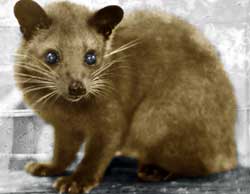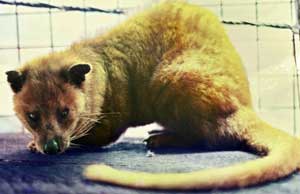Hopping on a bus on Friday evening for a night-long journey either to Moneragala or Knuckles, eating papaw and nothing else most of Saturday and Sunday while camping in the jungle, getting back home on Sunday night and reporting to his banking job right on time on Monday morning has been the willing “fate” of Channa Rajapakse.
Sometimes suspected by villagers of exporting animals collected from the jungles and at others facing the wrath of hunters who thought he was from the CID, 38-year-old Channa not even a zoologist was only following a hobby, but following it with a passion and determination that has paid off.
 |
| Sapumal kalawedda: Paradoxurus montanus |
Channa was not on the trail of a huge majestic beast like the elephant or the beautiful and sleek leopard. His mission was different………….to track the humble but endangered kalawedda (maram nai) or palm civet. The civet, a nocturnal creature, described in encyclopaedias as being “related to cats and hyenas but are more primitive”, is facing extinction in Sri Lanka as it is losing its habitat, being hunted for its meat and may also be falling victim to parasitic diseases.
And Channa has stumbled on a new species (Paradoxurus stenocephalus) and resurrected another hardly-mentioned one (Paradoxurus montanus), while also giving satisfaction to hundreds of people of seeing civets in the Dehiwela Zoo once again.
Recalling how it all started, Channa who is a Junior Executive Assistant at the e-banking section of the Commercial Bank, acknowledges with humility that he has no scientific background. He did maths. But after schooling at St. Sebastian’s College, Moratuwa, he developed an interest in elephants.
Channa visited each and every National Park, camera slung over shoulder, sometimes crawling on all fours to get close-ups of this mighty animal. This was in 1990.
Encouraged by his brother and sister-in-law who have a science background, who showed his photographs to the then Assistant Director of the Zoo, Dhammika Malsinghe, now Deputy Director, he was asked whether he was hoping to sell the photos. But when he said no, it was just a hobby, she had suggested that he do a research project.
And the research suggested was on the civet because, she had pointed out, there was hardly any documentation on this mammal. But there was one problem for Channa – he had never seen a civet in his life.
 |
| Golden palm civet: Paradoxurus aureus |
But a conversation he had had many years before with Dr. Wolfgang Dittus, when he was at the Kandy bank branch, was imprinted on his mind. He had contacted Dr. Dittus after seeing a cheque from the Smithsonian Institute for him, as he was engaged in research on primates in Sri Lanka.
“Concentrate on one species,” had been the advice of Dr. Dittus.
The search by Channa for the elusive civet started around 1998. With not even a photograph to go by, he traced the civet to a tiny stamp issued in connection with the endemic species of Sri Lanka.
It was then that Channa firstly decided to do a “full study” of the civet, going to Dr. Devaka Weerakoon, Senior Lecturer, Zoology Department of the Colombo University for advice. “His encouragement was immense, for I was just a banker,” says Channa gratefully.
There followed the paperwork, against indications that “without a science background” he would not get permission from both the Departments of Wildlife Conservation and Forest Conservation, because he had to study the civet by either trapping them in the wild or collecting skins and skulls of those slaughtered by hunters.
The department officials and their Research Committees were very helpful, says Channa.
Channa began by calling all National Parks and requesting their officials to tip him off if there was a sighting of a civet. Then carrying bagfuls of waraka along with tomahawk traps, he would set off to Moneragala or Knuckles helped by friends in those areas.
“Civets are very fond of waraka and they could be lured into the trap only if it was the off-season in the area for waraka and the delicious aroma came from the trap,” explains Channa, now getting his rabies shots, as he has also been bitten by them.
The first time he saw a real-life civet is etched in his memory. “It was dark and the animal had been slaughtered for its meat. Although known as the ‘golden palm civet’ its fur was brown,” says Channa.
It was chocolate brown (P. montanus) and not golden, leaving Channa puzzled. How could that be when the stamp indicated the latter? “The people called it the Sapumal kalawedda because it emits a scent similar to sapumal,” he explains.
 |
| Channa |
Then a year later, he was able to trap a few and they too were brown.
The crucial question came to mind – is this another species? Doubts assailed him, he was not a scientist. He was talking to scientists and experts, introduced by Sampath Goonatilake of IUCN. Some scientists had indicated that mention had been made in the 1700s of another species but the name decided on had gone into disuse.
Then an aged golden palm civet walked into his trap at Kalupahana in Knuckles. DNA tests were tried but failed.
A further surprise awaited Channa. In another trap he had laid at Knuckles was a golden palm civet with three prominent stripes (P. stenocephalus) on its back. “Usually the single stripe is not very prominent but blends with the other fur, but this was not so,” says Channa. The thought that raced through his mind was whether there was a third species.
With all this work, Channa had been sitting for his banking examinations but had not applied for any promotions because the hobby had now turned more or less to an obsession. He had even postponed his marriage.
“My parents, family and now also my wife and three-year-old son have put up a lot,” he smiles, adding that he is grateful to the Commercial Bank for allowing him to pursue this interest.
Having donated the civets that he had trapped to the zoo, he had initiated a breeding programme with the veterinary surgeons and other zoo staff there but so far they have not been able to safeguard the young from their own mothers.
 |
| At the British museum: On top skull of Sapumal kalawedda and bottom that of the golden palm civet |
“The sole golden civet died of age,” says Channa sadly.
Doing all the work on his own steam and own funds, Channa was by now feeling the strain. Later he had been able to secure some funds from the Biodiversity and Elephant Conservation Fund run by Jayantha Jayawardene because the traps are costly to build.
It was in 2004 that Kelum Manemandra-arachchi of the Wildlife Heritage Trust introduced him to Dr. Colin Groves from the Australian National University. “It was the day before my wedding and I rushed to the Zoo to meet him when Ms. Malsinghe called me,” says Channa, adding that Dr. Groves assured him that it was “definitely two species”.
Live animals, skins and skulls have all been studied, with Dr. Groves even making a trip to the Natural History Museum in London in 2005 to check out the skulls preserved there.
“In addition to the skins and skulls I collected, there were some skins at the National Museum in Colombo and skulls at the Colombo University,” says Channa.
Now that his work has been recognized internationally, what next?
A big survey of civets at Knuckles to find the three-striped ones among others and do follow-up studies is what Channa dreams of achieving.
Linnean Society of London, Zoological Journal says:
“Two species of palm civet are currently known from Sri Lanka: the widespread common species, Paradoxurus hermaphroditus (Pallas, 1777), and the endemic golden species, Paradoxurus zeylonensis (Pallas, 1778). The latter has two ‘morphs’, one golden and one dark brown, both of which are recorded from all three major biotic zones in Sri Lanka (wet zone, dry zone, and cloud forest). We have examined specimens of both ‘morphs’ from all zones, and conclude that there are actually several species involved: names are available for two of them, we describe a third as a new species, and we draw attention to a probable fourth species, based on two distinctive specimens, the provenance of which are unfortunately unknown. The name zeylonensis probably does not apply to a golden palm civet at all.”
This is how the prestigious Linnean Society of London, Zoological Journal , which had received Channa’s research along with the input of Colin P. Groves of the School of Archaeology & Anthropology, Australian National University, Canberra and Kelum Manemandra-arachchi of the Wildlife Heritage Trust of Sri Lanka, describes the findings. The findings received by the journal in September 2007 had been accepted for publication in January 2008 and been published this month.
The hardly-mentioned civet is Paradoxurus montanus and the new species is Paradoxurus stenocephalus.
|




